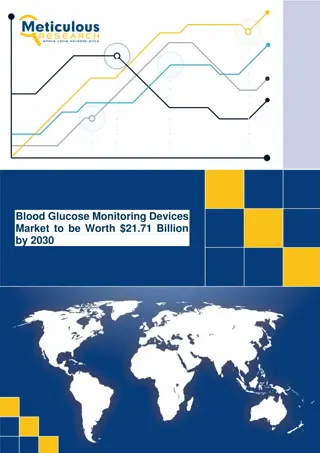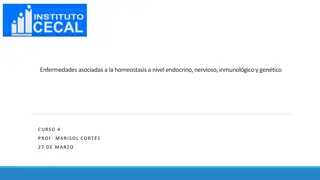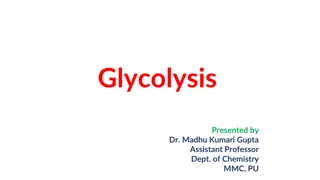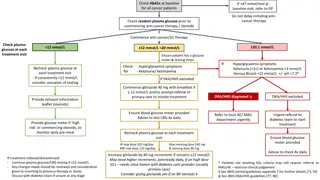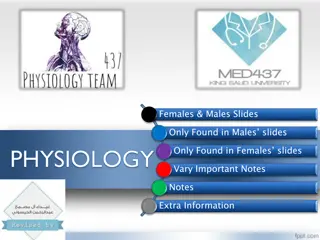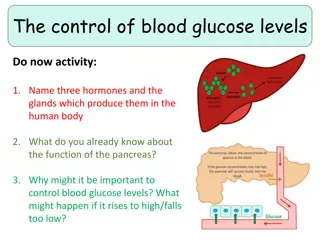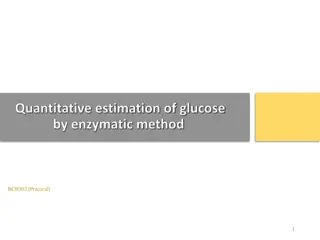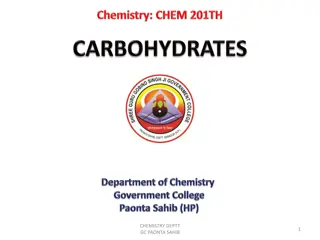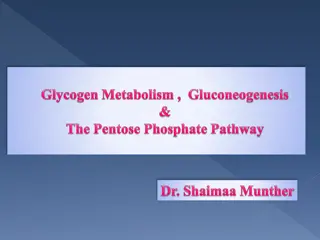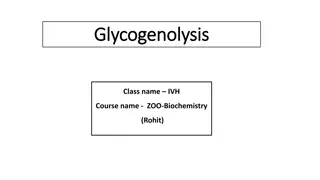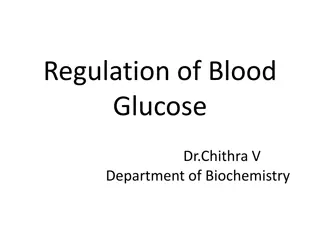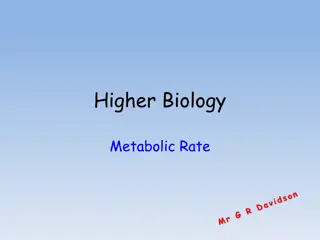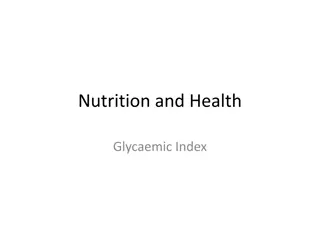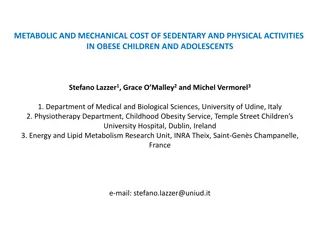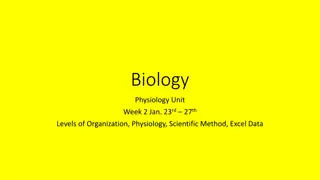Understanding Glucose Homeostasis in Metabolic Processes
Glucose homeostasis is crucial for controlling glucose metabolism and maintaining normal blood glucose levels in the body. It involves various metabolic sources, including dietary intake and gluconeogenesis. The liver plays a vital role in regulating blood glucose levels, while severe hypo- and hyperglycemia can lead to serious health issues. This process involves absorption, tissue utilization, glycogen formation, and breakdown mechanisms to ensure the body has a constant supply of glucose for energy needs.
Download Presentation

Please find below an Image/Link to download the presentation.
The content on the website is provided AS IS for your information and personal use only. It may not be sold, licensed, or shared on other websites without obtaining consent from the author. Download presentation by click this link. If you encounter any issues during the download, it is possible that the publisher has removed the file from their server.
E N D
Presentation Transcript
HbA NH2 H2O2 Cl2O7 KClO3 NAOH CH2O PO4 KMnO4 M E D I C I N E COOH KING SAUD UNIVERSITY Co2 MgCl2 H2O SO2 Doctors slides Doctors notes Important ExtraInformation HCN CCl4 CuCl2 SiCl4 Biochemistry Thyroid Hormones and Thermogenesis
O B J E C T I V E S By the end of this lecture, the Second Year students will be able to: Define glucose homeostasis and the metabolic processes involved Differentiate between different phases of glucose homeostasis Discuss the primary sources of energy and major organs utilizing glucose during the five phases of homeostasis Understand the role of hormones in maintaining glucose homeostasis
Glucose homeostasis A process that : Controls glucose metabolism and Maintains normal blood glucose level in the body Sources of glucose Metabolic sources (via gluconeogenesis): Dietary sources: Glucose is a major source of body s energy Dietary CHOs are digested to monosaccharides Starch provides glucose directly Fructose and galactose are converted to glucose in the liver The liver plays a key role in maintaining blood glucose level Glycerol, lactate, pyruvate, glucogenic amino acids why not glycogenolysis? Because glycogen is a polymer of glucose only, you re not making new glucose you re only bringing your own storage of glucose It is tightly controlled as the brain constantly needs glucose Severe hypoglycemia can cause coma and death Chronic hyperglycemia results in glycation of proteins, endothelial dysfunction and diabetes mellitus
Glucose homeostasis 1: glucose, fructose and galactose are absorbed to the blood stream 2: Some of it goes to the peripheral tissue to be used as energy, and the remaining goes to the liver to convert fructose and galactose into glucose 3: Some of the glucose is used to make glycogen but as we said before it has a limit for glycogen formation, so excess amounts of glucose will be converted into fatty acids and triglycerides then sent to adipose tissue for storage, then when the adipose tissue breaks down fat it produces glycerol which goes back to the liver and forms glucose again (gluconeogenesis) 4: When blood glucose levels go down > glycogen is broken down (glycogenolysis) and we start forming glucose from amino acids and lactate from muscles All the carbohydrate that comes from food (glucose-fructose- galactose) are stored in the liver as glycogen(glycogen stores). -When the body needs glucose it converts glycogen stores back to glucose via Glycogenolysis + also via gluconeogenesis *Cori cycle is the one that convert lactate into glucose
Phases of glucose homeostasis Phase I (Well-fed state) These phases are not separate from each other! It doesn't mean that one stops then the other starts. Glucose is mainly supplied by dietary CHOs (Exogenous) All body tissues use dietary glucose for energy in this phase Liver removes about 70% of glucose load after a CHO meal Some glucose is converted to glycogen for storage in the liver (glycogenesis) Excess glucose is converted to fatty acids and triglycerides in the liver These are transported via VLDL (very low density lipoproteins) to adipose tissue for storage Gluconeogenesis is inhibited in this phase Cori and glucose-alanine cycles are inhibited (both lactate and alanine are coming from the muscles) So when we re fasting during Ramadhan, what are we using for energy? We are NOT breaking down fat for energy, it s only glycogen that is broken down because it s used up to 24 hours, unless we reduce the intake of glucose so the storage will be less but still it needs more time to finish, or if we re exercising so we re consuming more energy, so it s a wrong belief that we break down fat
Phases of glucose homeostasis Phase II (Glycogenolysis) pre-fasting state. Phase II starts during early fasting when dietary glucose supply is exhausted Hepatic glycogenolysis (major) and gluconeogenesis(minor) maintain blood glucose level in this phase Major sources of blood glucose in this phase: Glycogenolysis and gluconeogenesis Phase III (Gluconeogenesis) Phase III starts when glycogen stores in liver are exhausted (< 20 hours) Duration of phase III depends on Feeding status Hepatic glycogen stores Physical activity Hepatic gluconeogenesis from lactate, pyruvate, glycerol and alanine maintains blood glucose level Major source of blood glucose in this phase: Gluconeogenesis
Phases of glucose homeostasis Phase IV (Glucose and KB oxidation) is a combination of glucose and fat Phase II: major source of glucose is glycogen(liver stops using glucose at this phase because it can survive on fatty acids) Phase III: major source of glucose is from Gluconeogenesis phase IV: Gluconeogenesis at its maximum level so there is no glycogen here + at this phase the brain starts to use ketone bodies Phase IV: the major source for brain is ketone bodies (glucose in minor) Several days of fasting leads to phase IV Gluconeogenesis starts to decrease FA oxidation increases KB accumulation KBsenterthe brain and muscle for energy production Brain uses both glucose and KB for energy
Phases of glucose homeostasis Phase V (FA and KB oxidation) Prolonged fasting leads to phase V Less dependence on gluconeogenesis All body tissues mainly use FA and KB oxidation for energy production Gluconeogenesis somewhat maintains blood glucose level in this phase High KB conc. and glucose levels inhibit proteolysis in muscle (conservation of muscle) When all fatand KBs are used up Body uses muscle protein to maintain blood glucose level
Phases of glucose homeostasis This table shows you all the 5 phases and what is the origin of glucose in each one and the tissues that are using it as well as the major fuel for the brain Ketone bodies are a byproduct of liver oxidation of fat, and these are :(acetone, acetoacetate and beta- hydroxybutarate) and they can be used as a source of energy
Phases of glucose homeostasis During this study, they were seeing how the glucose is being maintained by the body and divided it into 5 phases (but these phases are not very well- demarcated even though they mention the beginning and the end of each phase it could be different from person to another but the pattern is the same): Phase 1: starts from 0 after you get a meal and start starvation, the body will use glucose from the exogenous source Phase 2: starts from 4-6 hours at the max, in this stage you start breaking down your glycogen storage to provide glucose Phase 3: once you finish your glycogen storage you start gluconeogenesis by triglycerides to glycerol and some of the amino acids, the gluconeogenesis here is happening mainly by the LIVER. Phase 4: you still make glucose by gluconeogenesis but in this stage your forming it by both the liver AND the kidney but the MAIN ORGAN IS THE KIDNEY, then when you re breaking a lot of fatty acids they re converted to ketone bodies. So in this phase you use limited amounts of glucose because you need it more in RBCs and brain, so majority of tissues will be using ketone bodies for their energy and the brain uses them as well after glucose finishes. Phase 5: The person continues to use ketone bodies and by the end of this phase fatty acid stores are exhausted so we start breaking down proteins (so the function of your vital organs will be compromised) and if you continue starvation you die
Hormones and glucose homeostasis 1- INSULIN (lowers blood glucose level) Mechanism of action : Plays a major role in glucose homeostasis Synthesized by the b-cells of islets of Langerhans of pancreas A small protein composed of two chains Rise in blood glucose level stimulates insulin secretion Hyperglycemia Promotes entry of glucose into cells Action : The insulin receptor is present on the plasma membrane of cell Insulin is used for storage and usage of all body energy sources as well as preventing their break down Composed of ?-subunit (extracellular) ?-subunit (cytoplasmic) Binding of insulin to ?-subunit causes phosphorylation of ?-subunit This activates the receptor The activated receptor then phosphorylates intracellular proteins generating a biological response Inhibits: Stimulates: Gluconeogenesis Glucose uptake in muscle and adipose Glycogenolysis Glycolysis Lipolysis Glycogen synthesis ketogenesis Protein synthesis proteolysis Uptake of Ion (K+ and PO4)
Hormones and glucose homeostasis http://sigmanutrition.com/wp-content/uploads/2014/05/insulin-action.jpg 1- INSULIN (lowers blood glucose level) Insulin and CHO metabolism Promotes glucose uptake into cell: Glucose is diffused into cells through hexose transporters such as GLUT4 GLUT4 is present in cytoplasmic vesicles (they don t go to the surface of the cell unless insulin is bound to its receptor and signals are sent to these vesicles) Insulin binding to its receptor causes vesicles to diffuse into plasma membrane GLUT4 is inserted into the membrane Allowing glucose transport into the cell Brain and liver have non-insulin dependent glucose transporter Insulin deficiency causes diabetes mellitus Hyperinsulinemia is due to insulin resistance in: Diabetes mellitus or Metabolic syndrome
Hormones and glucose homeostasis 2-ANTAGONIZE insulin action Glucagon Glucocorticoids (Cortisol) Growth hormone Epinephrine A peptide hormone secreted by ?-cells of pancreatic islets in response to hypoglycemia A steroid hormone A protein hormone A catecholamine hormone secreted by adrenal gland secreted by anterior pituitary gland adrenal gland Increases glucose levels Stimulates glycogenolysis Activates hepatic gluconeogenesis It is inhibited by insulin Contributes to glucose homeostasis Maintains normal glucose levels in fasting Stimulatesgluconeogenesis in the liver Mobilizes amino acids for gluconeogenesis Stimulatesfat breakdown in adipose tissue Maintains blood glucose levels by: Inhibiting insulin action Stimulating gluconeogenesis in the liver Stimulates lipolysis in adipose tissue when blood glucose levels fall Promotes glycogenolysis in skeletal muscle (by increasing the expression of enzymes that break it down, but REMEMBER: that DOES NOT contribute to the homeostasis of glucose in blood)
QUIZ Q1 : Which one of the following is a complication of chronic hyperglycemia? A. Liver failure B. Kidney failure C. Endothelial dysfunction D. Nephropathy Q4 : Which one of the following is an action of insulin? A. Increased Gluconeogenesis B. Increased Glycogenolysis C. Increased Lipolysis D. Increased Glycogenesis Q5 : Which one of the following is correct about GLUT 4? A. It s present in Golgi apparatus B. It allows glucose transport into the cell C. It s insulin dependent in the liver and brain D. Insulin causes inhibition of GLUT4 Q2 : Excess glucose is converted in the liver during phase 1 into which of the following? A. LDL B. HDL C. Glycogen D. Fatty acids Q6 : Which one of the following cells secret Glucagon? A. Alpha B. Beta C. Gamma D. Delta Q3: In which one of the following phases of glucose homeostasis is gluconeogenesis is inhibited? A. I B. II C. III D. IV
QUIZ Q7 : The previous medical student girl came to your office, to make sure of the SAQ questions she answered in her endocrine block. And because you are erudite ( ) in endocrinology you will answer all of them. C) Name the 5 phases of glucose homeostasis and their main physiological event/function. 1. Phase I: Glycogenesis , inhibition of gluconeogenesis, Cori & glucose-alanine cycles 2. Phase II: Glycogenolysis and Gluconeogenesis. 3. Phase III: Gluconeogenesis from lactate, pyruvate, glycerol& alanine 4. Phase IV: Fatty acid oxidation leads to increased ketone body accumulation 5. Phase V: All body tissues use Fatty acids and ketone bodies oxidation for energy production. When FA and KBs are used up, proteolysis starts. A) Name 4 hormones that antagonize insulin action? 1. Glucagon 2. Cortisol 3. Growth hormone 4. Epinephrine B) How does the growth hormone contribute in maintaining blood glucose? 1. Inhibiting insulin action 2. Stimulating gluconeogenesis in the liver D) What does the duration of phase III depend on? 1. Feeding status 2. Hepatic glycogen stores 3. Physical activity Suggestions and recommendations Suggestions and recommendations 1) C 2) D 3) A 4) D 5) B 6) A
THANK YOU FOR CHECKING OUR WORK T E A M M E M B E R S TEAM LEADERS Hosam alkhathlan PLEASE CONTACT US IF YOU HAVE ANY ISSUE Mohammad Almutlaq Rania Alessa Faris alnafisah Abdulaziz alhusaini Abdulrahman alrashed Mohannad alzahrani



